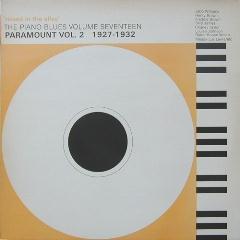The Piano Blues Vol. 17 - Paramount Vol.2 1927-1932 (1982)
The Piano Blues Vol. 17 - Paramount Vol.2 1927-1932 (1982)

1. Jabo Williams - Pratt City Blues 2. Henry Brown - Eastern Chimes Blues 3. Freddie Brown - Raised In The Alley Blues 4. Skip James - 22-20 Blues 5. Raymond Barrow - Walking Blues 6. Charley Taylor - Heavy Suitcase Blues 7. Barrel House Welch - Dying Pickpocket Blues 8. Louise Johnson - Long Way From Home 9. Louise Johnson - On The Wall 10. Charley Taylor - Louisiana Bound 11. Barrel House Welch - Larceny Woman Blues 12. Meade Lux Lewis - Honky Tonk Train Blues 13. Will Ezell - Playing The Dozen 14. Freddie Brown - Whip It To A Jelly 15. Henry Brown - Deep Morgan Blues 16. Jabo Williams - Jabo Blues Jabo Williams – piano (1,16) Henry Brown – piano (2,15) Freddie Brown – vocals, piano (3,14) Skip James – vocals, piano (4) Raymond Barrow – piano (5) Charley Taylor - vocals, piano (6,10) Barrel House Welch - vocals, piano (7,11) Louise Johnson - vocals, piano (8,9) Meade Lux Lewis – piano (12) Will Ezell – piano (13)
St. Louis-based barrelhouse pianist Jabo Williams is known only by the eight sides he cut in Paramount's Grafton, WI studio in May 1932. This was towards the end of the Paramount concern; Williams' records were circulated in low quantities and didn't have very wide distribution. The assumption that Williams was born in Pratt City, AL is based on references in his "Pratt City Blues," but the only thing definitely known about him outside of his recordings is that he was referred to Paramount by Jesse Johnson, a record store owner based in St. Louis. Recognition of the singularity of his playing among collectors was noted early; in the '40s and early '50s some of his tracks were re-released on the American Music, Steiner-Davis, and Jazz Information labels, all concerns directed at collectors. However this recognition apparently did not come early enough for Jabo Williams himself to be rediscovered, or even for his true first name to be known. --- Uncle Dave Lewis, Rovi
Henry Brown left Tennessee for St. Louis, MO, at the age of 12 and took up the piano while still in school. His playing style, an economical form of piano blues, was taught to him by a Deep Morgan Street blues player known to the public only as "Blackmouth." Brown later worked with St. Louis Jimmy Oden and trombonist Ike Rogers; with Rogers and guitarist Lawrence Casey, he formed a trio called the Biddle Street Boys. He recorded sides (often in tandem with Rogers) with Mary Johnson, among others, in between playing in clubs around St. Louis, where he lived most of his life and worked regularly right up through the mid-'70s. ---Bruce Eder, Rovi
Louise Johnson was a barrelhouse pianist and girlfriend of Charlie Patton’s who went to Grafton, Wisconsin to make records for Paramount with Patton, Willie Brown and Son House. She cut four sides at that session, her sole recorded legacy. ---sundayblues.org
Meade Lux Lewis was born in Chicago, Illinois and helped establish boogie-woogie as a major blues piano style in the 1930s and 1940s. Lewis took the rollicking piano form out of the clubs and cat houses and onto the concert stage in 1938 where its fast-flowing rhythms and charging solos delighted audiences and eventually laid the groundwork for rhythm & blues and later rock & roll. Lewis was a master boogie-woogie craftsman. He was heavily influenced by such boogie-woogie pioneers as Jimmy Yancey and Pine Top Smith. Lewis recorded "Honky Tonk Train Blues," his signature piece and a standard in the boogie-woogie repertoire, in 1927, though it wasn't released by Paramount Records until two years later. ---aaregistry.org
William Ezell, also sometimes billed as Will Ezell, was a popular blues pianist and recording artist, and a ubiquitous figure in the Paramount Records operation of the 1920s and early '30s. A technically brilliant pianist, showing the strong influence of jazz as well as blues in his work -- and with some similarities to the playing of Jimmy Blythe -- his roots were originally thought to be in Texas. More recently, however, would-be biographers have traced him to Louisiana, in the Shreveport area. He played venues in Detroit and Chicago, and was also known for his performances in the south -- Little Brother Montgomery apparently remembered his work, as did Walter Davis who, according to Bob Hall and Richard Noblett, recalled him working as an accompanist to Bessie Smith. He was a busy figure at Paramount, not only cutting a significant number of sides of his own, but also serving as the pianist-in-residence for a large number of other artists, and a general handyman and go-fer -- among his other functions, according to Hall and Noblett, he was given the task of accompanying the body of the label's best-selling artist, Blind Lemon Jefferson, for burial in Dallas. ---Bruce Eder, Rovi
download (mp3 @128 kbs):
uploaded yandex 4shared mega mediafire zalivalka cloudmailru oboom uplea








